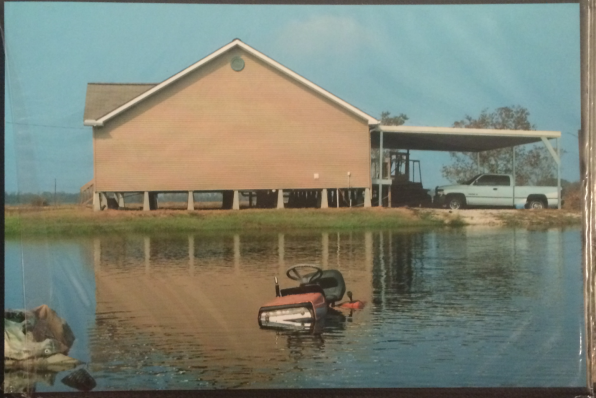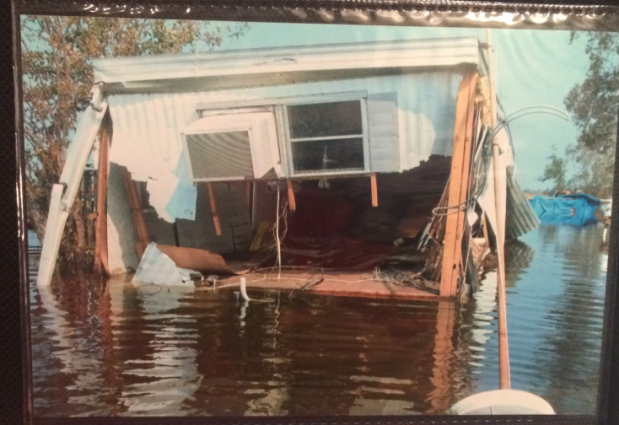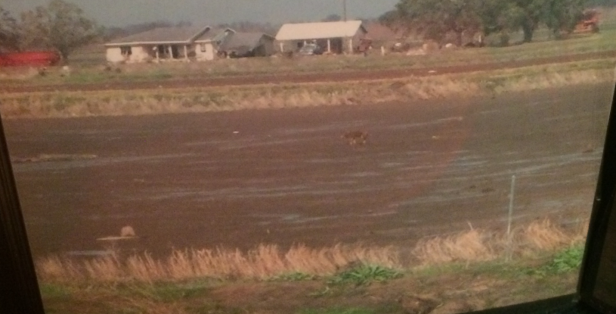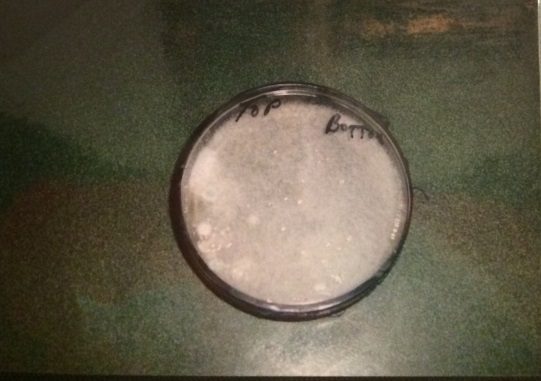
Storm Surge Days After Rita’s Landfall. Photo courtesy of Kayla Hebert
Close your eyes. Do you feel the wind, smell the salty rain water, and hear nothing but silence? Now you see this humongous wall of water headed your way. You try to run, but it is too late! There is nowhere to go but the attic of your house. Hopefully you will be safe from the rising water and any creatures lurking in the muddy waters that are starting to rise with each step you take. Now you open your eyes to what you thought was a dream, but you turn on the news and see that you are wrong. Hurricane Rita may have only taken hours to pass through, but it caused damage that would last longer than expected.Many houses and lives were lost due to this devastating storm, but some of the things that people do not seem to think about are the environmental effects that Hurricane Rita had on all of the land that it ripped apart. The wind that you felt did not just brush across your face and send a chill down your spine, but in fact it ripped branches and leaves from their trees. The salty water that you smelt caused major damage to the soil and salt content of all the areas touched by the filthy waters of Hurricane Rita, especially the rice and sugarcane crops. The silence that you heard was the absence of the birds and other creatures that were scared off by the environmental changes that Hurricane Rita started before it even made its appearance.
The Arrival of Hurricane Rita
Where we you on September 24, 2005? Many people of Vermilion Parish were in a slight panic, praying and hoping that Hurricane Rita would not shift eastward and cause even more damage to their property and homes. The storm was on track to make landfall on the Texas/Louisiana border. The meteorologists were tracking Hurricane Rita in the Gulf of Mexico as a category 5, with winds over 150 miles per hour. By the time of landfall at 10 PM, Hurricane Rita had disintegrated to a category 3, with winds now at 120 miles per hour (Michael Kurth, The Rita Report: A summary of the social and economic impact and recovery of Southwest Louisiana one year after Hurricane Rita, Louisiana Recovery Authority, 2006, Accessed March, 9, 2014, http://www.nola.com/katrina/pdf/091806_lra_ritareport,pdf). This seemed like a positive change, but little did everyone know that the 20 feet storm surge to follow would cause even more of a headache than the passing through of the hurricane.
Hurricane Rita’s Landfall

Destruction from Rita’s Waters. Photo courtesy of Kayla Hebert
Hurricane Rita had been downgraded to a category 3 storm by the time it made landfall. So how much damage could a storm of this nature cost? According to “The Rita Report,” produced by the Louisiana Recovery Authority, Hurricane Rita was in fact the third most expensive natural disaster in United States history (Michael Kurth, The Rita Report: A summary of the social and economic impact and recovery of Southwest Louisiana one year after Hurricane Rita, Louisiana Recovery Authority, 2006, Accessed March, 9, 2014,
http://www.nola.com/katrina/pdf/091806_lra_ritareport,pdf).The estimated amount of destruction was $10 billion. Most of the damage was not from the initial impact of the storm, but actually from the storm surge and standing water that came in like a brick wall and refused to leave until many days later. There were a total of two recorded storm surges that followed Hurricane Rita. The first surge was an estimated height of 20 feet. This surge wiped out many buildings and homes, especially the ones that were located in the flood zones. The second surge was recorded at 10 to 13 feet (Corbitt Kerr, “U.S.
IOOS coastal and ocean modeling testbed; inter-model evaluation of tides, waves, and hurricane surge in the Gulf of Mexico,” Journal of Geophysical Research 118 (October 2013) C10:5129-5172). This surge finished off any buildings that were barely hanging on. These surges flooded over 600 square miles of marsh and agricultural land, causing extensive damage to crops and livestock, and also damaged countless homes. Many people believe that the flooding could have been prevented by enhanced systems of levees, canals, and locks (Michael Kurth, The Rita Report: A summary of the social and economic impact and recovery of Southwest Louisiana one year after Hurricane Rita, Louisiana Recovery Authority, 2006, Accessed March, 9, 2014,
http://www.nola.com/katrina/pdf/091806_lra_ritareport,pdf).
Previous Hurricanes
Hurricane Rita was not the first major hurricane to hit Vermilion Parish. On October 3, 2002, Hurricane Lili made landfall near Intracoastal City. This storm was originally headed for the Louisiana and Texas border. Upon arrival, Hurricane Lili weakened to a category 1 hurricane. Wind gusts reached 120 mph and were followed by a storm surge of 12 feet. This storm caused over $790 million in damage to Louisiana. Crops were badly affected, such as sugar cane, and the damages due to the destruction of these crops were estimated to be $175 million. Vermilion Parish, the point of landfall, was the hardest hit area. Nearly 4,000 homes were damaged by the wind gusts and storm surge (National Weather Service Forecast Office, Lake Charles, Louisiana (2002). “LILI”. National Weather Service. Archived from the original on 2003-04-17. Retrieved 2008-04-08). The storm downgraded enough to not cause major damage to the area, but due to the storm surge, many crops were affected. The soil that the crops grew in now contained higher levels of salt than was needed to grow a successful sugarcane crop. Overall, Vermilion Parish ended up catching a break with Hurricane Lili.
Many people believed that since Mother Nature had already hit close to home 3 weeks earlier in the form of Hurricane Katrina in August 2005, that there would be no way for us to see anything as catastrophic so soon after. Some people who were scared off by the damage caused by Hurricane Katrina, evacuated at the first sign that Hurricane Rita was possibly headed in the direction of Vermilion Parish. Even though the eye was headed to the Texas/Louisiana border, the right side of the hurricane traditionally has the heaviest backlash of the storm. As a result, people experiencing the right portion of the storm also get affected by the rising waters and storm surges. Due to the fact that Vermilion Parish was on the right side of the storm, a mandatory evacuation was set in place three days before the day of landfall for anyone that lived south of Highway 14. A small group of people decided to press their luck and stay to ride out the storm, which caused a door to door evacuation system to be enacted (A Narrow Escape, Home video by Boyd and Cliff Choate (2005: CNN) -2:14:58~-2:11:17). According to reports from Mark Piazza, the Mayor of Abbeville, approximately one thousand people ignored the door-to-door evacuation and ended up needing to be rescued by the National Guard (“The latest on Rita and Katrina,” Posted on September 26, 2005, http://edition.cnn.com/2005/US/09/24/news.update.sat/).
Effects of Hurricane Rita
Many people did not know what to do with Hurricane Rita on its way. Two years before, Vermilion Parish had been affected by Hurricane Lili, which caused damage to a large portion of the parish. Many people were terrified of the high powered winds and towering storm surges that were supposed to result from Hurricane Lili, but ended up almost having nothing to worry about. Only a portion of the parish was affected. The warnings from Hurricane Lili were misleading to most families. Many of the warning signs for Hurricane Rita were the same as the ones from Hurricane Lili. The meteorologists were predicting high-powered winds and storm surges. Little did everyone know that this storm would end up worse than Hurricane Lili.
Hurricane Rita made landfall as a category 3 storm. In Vermilion Parish, the storm surge was at a height of 10 feet, which completely flooded Pecan Island, Intracoastal City, and Delcambre (“CNN.com- The latest on Rita and Katrina- Sep 24, 2005”. CNN. Retrieved May 4, 2010). As many people would soon find out, Hurricane Rita would turn out to cause far worse problems than Hurricane Lili, and many of those problems would lead to issues that would cause the environment to be effected for many years to come.
Environmental Destruction of Hurricane Rita
Hurricane Rita did cause massive damage to houses in Vermilion Parish. This was due to the height and solidity of the wall of water that came rolling through. However, many people overlooked the environmental impact for which Hurricane Rita was responsible. This storm caused many trees to uproot and lessen the region’s protection from future natural disasters. A barrier of trees along the coastlines of Vermilion Parish had allowed for the rolling waves to break apart and cause less damage.
Another major impact that almost everyone in Vermilion Parish was affected by in some way, was the deposit of salt water that was now in the soil trying to grow major crops such as rice, sugarcane, and crawfish. In 2005, this author conducted personal research to determine the salinity levels of the water three years after Hurricane Rita hit. While conducting research, this author came upon an article from the LSU College of Agriculture that stated that after conducting research, soil salinity levels ranged from 268 to 4,329 ppm. Some crops, such as sugarcane, are moderately sensitive to salt. Damaging levels of soil salinity for sugarcane crops range from 640 to 1200 ppm. By the time the plots were harvested in 2006, enough rainfall had accumulated to help wash away some of the salt in the soil. The salinity levels decreased to almost two-thirds from the initial amount. Another survey was conducted in 2008 after Hurricane Gustav and Ike which lead to similar findings (Sonny Viator, Jimmy Flanagan, Andrew Granger, Blair Hebert, Barton Joffrion, Ben Legendre and Rick Louque, Influence of Soil Salinity on Sugarcane (lsuagcenter.com, 2011)). The salt levels that remained in the water after Hurricane Rita were damaging to crops. Crawfish do not like salty water and therefore buried themselves early which caused the sale of crawfish to decrease, and fishermen lost a very large amount of money. Other crops such as rice and sugar cane had too much salt in the soil to supply the necessary nutrients for the crops to grow, therefore causing a scarcity in the major cash crops of this parish (Andrew Tweel, “Landscape-scale analysis of wetland sediment deposition from four tropical cyclone events,” PloS One 2012 (November 2012) e50528). Another area of Vermilion Parish that was harshly damaged was the cattle industry. Many farmers did not think about the possibility of a storm surge and did not move their cattle from low lying areas, which caused those herds of cattle to drown when high water rushed in.
Governmental Assistance Needed
The government had to assist the families that lost their homes due to the destructive winds and water levels of Hurricane Rita. With the destruction and flooding of almost every home in Vermilion Parish, especially those south of Highway 14, a large number of FEMA trailers were brought into the parish to allow people to have a place to live while attempting to rebuild. Little did many people know, these FEMA trailers would be unsafe for people to live in. These trailers were basically cheap versions of a camper — most trailers only had room for one king size bed, one set of bunk beds, and a sofa. There was also only one toilet, one small tub, and one small kitchen area with the basic essentials. As a result, these trailers were not well equipped to live in for bigger families, especially since many of these trailers had formaldehyde in them. Formaldehyde is an industrial chemical that is linked to nasal cancer, respiratory problems and leukemia. It was used to make particle board and plywood in the campers (CNN Wire Staff, “Nearly $43 million settlement proposed over FEMA trailers,” Posted on May 31, 2012, http://www.cnn.com/2012/05/30/justice/fema-trailer-settlement/). Many people were grateful for the opportunity to obtain a FEMA trailer to live in after Hurricane Rita, but many were not aware of the harmful effects that these trailers would cause.
The Aftermath of Hurricane Rita

Destroyed Crops. Photo courtesy of Kayla Hebert
It has been almost nine years since the landfall of Hurricane Rita. This has allowed time for the rice, sugar cane, and crawfish crops to replenish and become successful cash crops once again for Vermilion Parish. Even though many areas of land have bounced back prior to this storm, other areas are now submerged under water and of no use to anyone. Many miles of coastline have disappeared and eroded away from our parish (Monica Palaseanu-Lovejoy, “Land Loss Due to Recent Hurricanes in Coastal Louisiana, U.S.A.,” Journal of Coastal Research (Spring 2013) 63: 97-109). Vermilion Parish was able to overcome many of the obstacles and once again become prosperous.

Mold Living within the House. Photo courtesy of Kayla Hebert
As people of Vermilion Parish are fearful of the damages that hurricanes can cause after witnessing the destruction from Hurricanes Katrina and Lili, there was no hesitation when the evacuation was set in place. A portion of the population of Vermilion Parish was now populated by victims of Hurricane Katrina that were merely trying to escape and rebuild their lives. These people were not happy about having to relocate again for their own safety, but they were joined by many other Vermilion Parish natives who were not taking any chances with this hurricane. Many believed that the only place for safety was in the northern portion of the state. Once people relocated, a portion of them decided to stay and make a permanent home there. This relocation caused Vermilion Parish to suffer. The main group of people that hurt the environment of Vermilion Parish was the farmers. The farmers that chose to leave and not come back abandoned their crops. This led to unused land that could have been cared for and replenished to help grow cash crops to assist in the rebuilding of Vermilion Parish. Even with the portion of the population that decided to abandon Vermilion Parish post storm, it was able to come around in a few years and become almost as good as new.
Vermilion Parish has had its fair share of natural disasters, but Hurricane Rita is definitely one for the books. This storm came in strong, but thankfully weakened before its arrival. It still managed to damage the environment by forcing evacuation, becoming the third most expensive natural disaster in U.S. history, uprooting trees that were a protection from future disasters, destroying defenseless homes, eating away at the soil and leaving behind tremendous amounts of salt that were unhealthy for crops, drowning another cash crop of cattle, causing FEMA trailers to be brought in and cause more damage to people living inside them, and introducing mold to the very humid environment. It was almost impossible for everyone and everything to be prepared for Hurricane Rita. Vermilion Parish was, in my opinion, a little more prepared than other areas because they experienced a test run with Hurricane Lili. Many residents learned from the mistakes, such as staying to ride out Hurricane Lili, seeing first-hand the destruction that a single nature-made circle of wind and rain can cause, and understanding the complications from cleaning up the aftermath. Hopefully, the residents of Vermilion Parish will continue to take hurricanes seriously in the future and have learned from the past.








